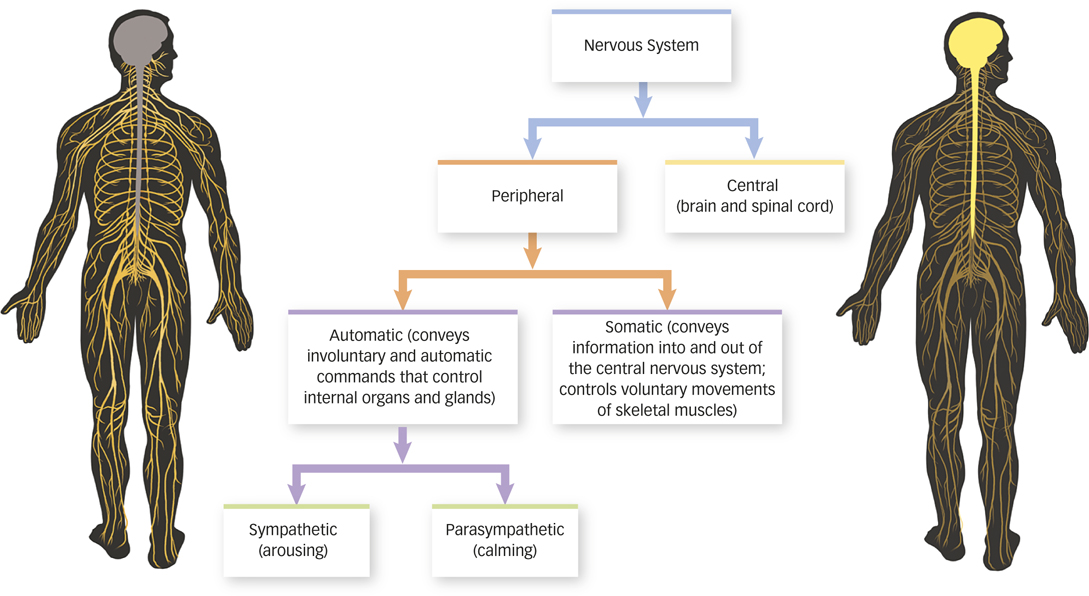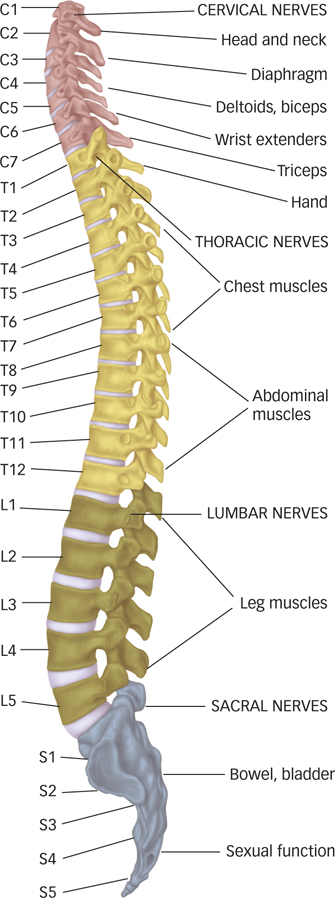3.3 The Organization of the Nervous System
We’ve seen how individual neurons communicate with each other. What’s the bigger picture? Neurons work by forming circuits and pathways in the brain, which in turn influence circuits and pathways in other areas of the body. Neurons are the building blocks that form nerves, or bundles of axons and the glial cells that support them. The nervous system is an interacting network of neurons that conveys electrochemical information throughout the body.
nervous system
An interacting network of neurons that conveys electrochemical information throughout the body.
There are two major divisions of the nervous system: the central nervous system and the peripheral nervous system (see FIGURE 3.7). The central nervous system (CNS) is composed of the brain and spinal cord. The central nervous system receives sensory information from the external world, processes and coordinates this information, and sends commands to the skeletal and muscular systems for action. The peripheral nervous system (PNS) connects the central nervous system to the body’s organs and muscles. Let’s look at each more closely.

central nervous system (CNS)
The part of the nervous system that is composed of the brain and spinal cord.
peripheral nervous system (PNS)
The part of the nervous system that connects the central nervous system to the body’s organs and muscles.
The Peripheral Nervous System
The peripheral nervous system is itself composed of two major subdivisions, the somatic nervous system and the autonomic nervous system (see FIGURE 3.7). The somatic nervous system is a set of nerves that conveys information between voluntary muscles and the central nervous system. Humans have conscious control over this system and use it to perceive, think, and coordinate their behaviors. For example, reaching for your morning cup of coffee involves the elegantly orchestrated activities of the somatic nervous system: Information from the receptors in your eyes travels to your brain, registering that a cup is on the table; signals from your brain travel to the muscles in your arm and hand; feedback from those muscles tells your brain that the cup has been grasped; and so on.
somatic nervous system
A set of nerves that conveys information between voluntary muscles and the central nervous system.
In contrast, the autonomic nervous system (ANS) is a set of nerves that carries involuntary and automatic commands that control blood vessels, body organs, and glands. As suggested by its name, this system works on its own to regulate bodily systems, largely outside of conscious control. The ANS has two major subdivisions, the sympathetic nervous system and the parasympathetic nervous system. Each exerts a different type of control on the body. The sympathetic nervous system is a set of nerves that prepares the body for action in challenging or threatening situations, and the parasympathetic nervous system helps the body return to a normal resting state (see FIGURE 3.8). For example, imagine that you are walking alone late at night and frightened by footsteps behind you in a dark alley. Your sympathetic nervous system kicks into action at this point: It dilates your pupils to let in more light, increases your heart rate and respiration to pump more oxygen to muscles, diverts blood flow to your brain and muscles, and activates sweat glands to cool your body. To conserve energy, the sympathetic nervous system inhibits salivation and bowel movements, suppresses the body’s immune responses, and suppresses responses to pain and injury. The sum total of these fast, automatic responses is that they increase the likelihood that you can escape. When you’re far away from your would-

autonomic nervous system (ANS)
A set of nerves that carries involuntary and automatic commands that control blood vessels, body organs, and glands.
66
sympathetic nervous system
A set of nerves that prepares the body for action in challenging or threatening situations.
parasympathetic nervous system
A set of nerves that helps the body return to a normal resting state.
What triggers the increase in your heart rate when you feel threatened?
67
The Central Nervous System

Compared to the many divisions of the peripheral nervous system, the central nervous system may seem simple. After all, it has only two elements: the brain and the spinal cord. But those two elements are ultimately responsible for most of what we do as humans. The brain supports the most complex perceptual, motor, emotional, and cognitive functions of the nervous system. The spinal cord branches down from the brain to relay commands to the body.
The spinal cord often seems like the brain’s poor relation: The brain gets all the glory and the spinal cord just hangs around, carrying out the brain’s orders. But for some very basic behaviors, the spinal cord doesn’t need input from the brain at all. Connections between the sensory inputs and motor neurons in the spinal cord mediate spinal reflexes, simple pathways in the nervous system that rapidly generate muscle contractions. If you touch a hot stove, the sensory neurons that register pain send inputs directly into the spinal cord (see FIGURE 3.9). Through just a few synaptic connections within the spinal cord, interneurons relay these sensory inputs to motor neurons that connect to your arm muscles and direct you to quickly retract your hand.

spinal reflexes
Simple pathways in the nervous system that rapidly generate muscle contractions.
What important functions does the spinal cord perform on its own?
More elaborate tasks require the collaboration of the spinal cord and the brain. The peripheral nervous system sends messages from sensory neurons through the spinal cord into the brain. The brain sends commands for voluntary movement through the spinal cord to motor neurons, whose axons project out to skeletal muscles. Damage to the spinal cord severs the connection from the brain to the sensory and motor neurons that are essential to sensory perception and movement. The location of the spinal injury often determines the extent of the abilities that are lost. As you can see in FIGURE 3.10, different regions of the spinal cord control different systems of the body. Individuals with damage at a particular level of the spinal cord lose sensations of touch and pain in body parts below the level of the injury, as well as a loss of motor control of the muscles in the same areas. A spinal injury higher up the cord usually predicts a much poorer prognosis, such as quadriplegia (loss of sensation and motor control over all limbs), breathing through a respirator, and lifelong immobility. On a brighter note, researchers are making progress in understanding the nature of spinal cord injuries and how to treat them by focusing on how the brain changes in response to injury (Blesch & Tuszynski, 2009; Dunlop, 2008), a process that is closely related to the concept of brain plasticity that we will examine later in this chapter.
68
SUMMARY QUIZ [3.3]
Question 3.7
| 1. | The _____________ automatically controls the organs of the body. |
- autonomic nervous system
- parasympathetic nervous system
- sympathetic nervous system
- somatic nervous system
a.
Question 3.8
| 2. | When you feel threatened, your _____________ nervous system prepares you to either fight or run away. |
- central
- somatic
- sympathetic
- parasympathetic
c.